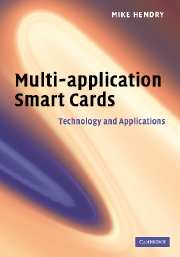21 - Prognosis
from Part IV - Implementation
Published online by Cambridge University Press: 11 August 2009
Summary
Technology
It will be clear from the rest of this book that the availability of technology is no longer a limiting factor preventing the deployment of multi-application smart-card schemes. However, further technology developments will continue to appear and some of these will be distinctly helpful by allowing a wider range of applications, or by making existing applications work better or at lower cost.
Microcontrollers
At the chip level, semiconductor technology as a whole continues to advance in line with Moore's Law: doubling the number of gates per chip every eighteen months. In the case of microcontroller chips, the 0.12–0.15 μm technologies that are regarded as leading-edge in 2006 are believed to be close to the limit for E2PROM; however, flash memory is being used to grow total memory sizes into the megabyte range, and this technology will be used increasingly in combination with E2PROM to provide the memory sizes required by the telecommunications industry today, and probably for multi-application cards in the near future.
In 2000, I forecast that smart-card microcontrollers would be using 0.1 μm processes by 2005; this turns out to have been optimistic, but this level is now regularly used for DRAM products and should be achievable by 2007 for microcontrollers, moving to 0.07 μm or less by 2010.
Memory sizes for microprocessor cards, currently mostly in the range 4–128 kB, are likely to rise over the next few years to 32 kB–8 MB, with a wider range of combinations of memory types, perhaps configurable at a relatively late stage in the manufacturing process.
- Type
- Chapter
- Information
- Multi-application Smart CardsTechnology and Applications, pp. 228 - 234Publisher: Cambridge University PressPrint publication year: 2007



